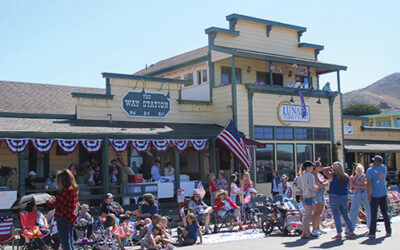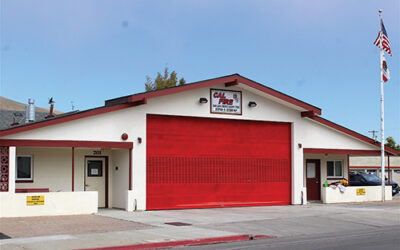The folks leading the effort to qualify a ballot initiative that would give voters a say over a proposed giant battery storage plant in Morro Bay, defended their efforts before a group of local business people, as concerns about public safety and economic harm clashed.
The Embarcadero Master Leaseholders Association sponsored the July 11 event at Dutchman’s Seafood House. The Dutchman’s dinning room was filled with about 40 people, there to listen to the goals and ask questions on the initiative’s impacts on the future of the waterfront.
World’s Biggest
Called a Battery Energy Storage System or BESS, the project proposed by power plant owner Vistra Energy, would see a 600 megawatt lithium-ion battery plant built on about 22-acres of the 100-acre power plant property. The BESS would be housed in three huge buildings and have about 75,000 battery packs. It would be the largest such facility in the world.
Vistra is currently in the environmental review stage of its project, with a consultant working on an environmental impact report that should be released sometime around the end of this year or early next.
Industrial battery plants like this are touted as vital cogs in the State’s push toward clean energy generation in the power grid. The plant would store excess solar and wind energy for use when supply falls off and demand remains high. The plant is expected to be in operation for 20 years.
Opposition Group
The citizens’ group, Preserve Estero Bay (see: www.PreserveEsteroBay.com) was represented by Barry Branin, Betsy Cross and Rachel Wilson.
Fearing the inherent fire dangers of lithium-ion batteries, Preserve Estero Bay is gathering signatures of registered voters to place their initiative on a future ballot. In essence the measure would lock in the current zoning that was placed on the power plant property by the recent update of the General Plan/Local Coastal Plan (GP/LCP).
That document lists the power plant as Visitor-Serving/Commercial and would have to be changed to allow the industrial BESS project to be built there.
Normally, such a change is done as part of a regular project review — simply put, if you approve a conceptual project (issue a use permit), you approve the zoning change that goes with it.
But the Preserve group’s initiative would deliver a curveball and require the City to seek approval from a majority of voters in order to approve a zoning change. So the matter boils down to no zoning change means no project approval.
Measure D
It would also reaffirm the voter-approved Measure D zoning for the Embarcadero from Beach Street north to Morro Rock. That zone is reserved for commercial fishing uses and uses that support commercial fishing, as well as recreational fishing.
Before the meeting, the Master Lease Holders group sent out a set of questions to guide the presentation towards the issues they are concerned about most.
Their biggest concern was about the sheer size of the V-S/C zone of the power plant plus the soon-to-be demolished sewer plant site on Atascadero Road, saying it’s bigger than Disneyland and many times larger than the existing Embarcadero is now. What do the proponents propose be built there?
They sought to know how many new hotel rooms, retail and restaurant spaces, and what other visitor serving uses do they see being built?
Branin responded that “This initiative affirms the General Plan. We’re not changing anything.”
Event Center
Wilson put up one slide suggesting a possible alternative use — an events center with a 500-600 seat outdoor amphitheater, two, big exhibit buildings with kitchens for private parties and public events, and leave the rest open for parking, a carnival or circus. The open area could also be used for RV camping to support the Harbor Department.
The room was a bit chaotic when the slide went up and no real consideration was given to it, though someone did blurt out “Who’s going to pay for that?”
Brown Site Be Gone
Branin said over the years, the big industrial facilities in town have closed and been removed. He pointed out the Chevron Marine Terminal closed in 1999 after 70 years of shipping oil out of Estero Bay.
There was also a Navy Fuel Depot supplying the Lemoore Naval Air Station on Panorama Drive at one time that was closed and just recently torn down and cleaned up; and the power plant, which Vistra closed in 2014 and has agreed to tear down by 2028 or pay the City $3 million.
Branin said the power plant is a “brown site,” i.e., an old industrial site presumed to be polluted to some degree. “It needs to be cleaned up,” Branin said.
He said the General Plan zoning change was meant to remove the last big brown site in town. It was also changed before Vistra proposed the BESS.
Change Could Be Bad
Several folks in the audience were concerned about the effects on Measure D — with business owners in that zone worried their grandfathered-in, protected status could be changed or that the Measure D area was being expanded. Where are the protections for them?
On the other hand, fishermen were concerned they’d lose the Measure D protections for the facilities they need to survive.
Branin, Cross and Wilson all reiterated that the initiative does not change the zoning, it just gives voters a chance to veto or approve whatever project eventually goes before the City Council, if it means a zoning change.
Roadblocks Put Up
Bob Fowler of Morro Bay Landing and the Master Lease Holders group was very concerned about putting up a significant roadblock to all future development projects.
No developer, “would want to go through a process like this,” Fowler said. It would put the area into visitor-serving/commercial zoning in perpetuity, and bypass representative government.
“The land use process is an important process,” Fowler said, one that he’d rather have elected representatives make decisions on than voters.
Fowler mentioned Assembly Bill 205, a State law that gives the California Energy Commission power to take over land use authority on projects like this BESS from the local authority should the project reach an impasse.
He was concerned about losing local control over the project, and losing the ability to put special conditions on Vistra that would benefit Morro Bay.
If the project stalls locally, Fowler said Vistra could immediately appeal to the Energy Commission.
Zoning Isn’t Secure
Someone asked why do an initiative? Did they not trust the City Council?
“You can change zoning on any property,” Branin responded. “All it takes is three [council] votes to change the land use.” And if it’s a ‘non-conforming use’ meaning the zoning doesn’t match the proposed use, it could be denied by the City Council. But Vistra could then appeal to the Coastal Commission.
So it seems the City could lose control of the project to more than one State agency.
Petition Drive
Preserve Estero Bay needs over 800 voter signatures from people registered in Morro Bay with a deadline in mid-October. If enough signatures can be verified it goes to the City Council for a vote on whether to accept it as presented into the municipal codes or let it appear on the ballot.
If it goes to a vote, the next election is the March 2024 Primary. The council could also call a special election, but the costs would be high. How that jibes with the BESS project’s EIR work schedule remains to be seen.
If the initiative qualifies for the ballot, the City Council could be expected to wait to hear from voters before taking any actions on Vistra’s $490 million project and put off consideration of the EIR.
Wedge Issue
Also, a majority of council members — mayor and two council seats — are up for election in November 2024, and the issue is likely to be a factor in those races.
Big issues like this, which Morro Bay has faced before, become wedge issues to distinguish candidates vying for city council. How that shakes out is usually split with one side staunchly in favor and the other equally committed against.
Opponents of the project already have yard signs out around town with a circle with red slash over a computer rendering of the plant that Vistra created.
It’s also conceivable that the initiative could be approved in March and come into play in November, depending on where Vistra’s project stands at the time. The initiative would go into effect immediately, should it pass.
If it fails, the project could be expected to move forward quickly, it’s fate placed solely in the hands of representative government.


